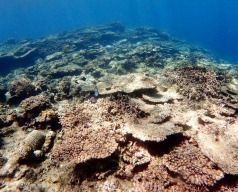Japan’s largest coral reef has not recovered from previous years’ wide-scale bleaching

Dead coral reef off the western coast of Ishigaki Island, July 2017 (Photograph courtesy of the Ministry of the Environment)
July 21, 2017 Ryukyu Shimpo
The Ministry of the Environment’s Naha Environment Bureau announced on July 20 the results of a June survey of 35 locations in the Sekisei shoko coral reef, Japan’s largest reef, located between Ishigaki and Iriomote islands in Okinawa. The results showed an average coral cover of 12.5%, a sharp decline from the 29.5% cover indicated in the same survey taken from July-August of the previous year.
The average bleaching rate was 19.7%. A surveyor from the Naha Environment Bureau indicated that the decline in cover rate was an effect of last year’s wide-spread bleaching phenomenon, noting, “This summer we need to take particular care with areas in the reef that were heavily bleached or declared dead in last year’s survey.”
It is believed that the warm ocean temperatures last summer were the cause of the wide-spread bleaching throughout Okinawa, resulting in bleaching in over 90% of the Sekisei shoko coreal reef, and 70% being declared dead. The situation had become so bad that both the Ministry of the Environment as well as researchers from both Okinawa and elsewhere elected to declare an emergency.
Regarding this summer’s results, a representative from the Ministry of the Environment noted that, “at this point in time, [the results] do not confirm a serious bleaching phenomenon,” however they indicated their persistent concern of whether or not the coral could endure having not completely recovered from the previous year’s grueling conditions.
After last year’s bleaching, the Ministry of Environment’s Nature & Parks department conducted a supplemental survey around Miyako, Ishigaki, and Iriomote Islands from June 28 through July 8. In many of the surveyed locations, the amount of dead staghorn coral was glaring, and at two points off the western coast of Ishigagi Island, the coverage rate had decreased a staggering 40% compared to the previous survey. In Sakiyama Bay of the coast of Iriomote Island, there were three locations were bleaching exceeded 70%.
(English translation by T&CT and Sam Grieb)
Previous Article:Construction companies and prefectural police form council to eliminate organized crime from Schwab construction
Next Article:LDP’s Nikai brings up importance of the Okinawa problem with U.S. Congressman Thornberry
[Similar Articles]
- Majority of Sekisei shoko coral reef dies with 97 % extremely severely bleached
- Survey shows coral in Oura is “healthy” with some bleaching
- MIyako Island coral reef dies due to high water temperatures
- 80 percent of Ishigaki Island’s coral reefs becoming bleached
- Coral bleaching confirmed at Kunigami for the first time since 1998
 Webcam(Kokusai Street)
Webcam(Kokusai Street)


